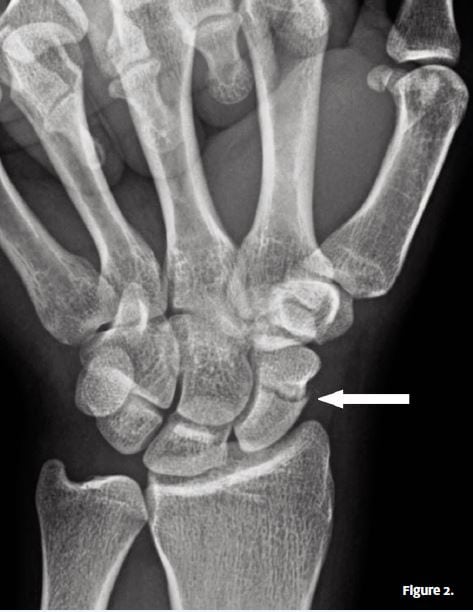The Resolution

Differential Diagnoses
- Normal findings on wrist x-ray
- Rolando fracture
- Bennett fracture
- Carpometacarpal dislocation
- Ulnar styloid fracture
Diagnosis
Scaphoid fracture (Figure 2).
Learnings
Most wrist injuries are caused by a fall onto an outstretched hand. If the point of maximal impact is over the thenareminence, an injury to the scaphoid bone and its associated ligaments is more likely. The scaphoid fracture is the most common carpal bone fracture, with most fractures occurring at the mid aspect of the scaphoid. About a quarter of such fractures occur in the proximal third of the bone, and 10% occur in the distal third. In up to one quarter of suspected scaphoid fractures (even with negative x-ray findings), the suspected diagnosis ultimately turns out to be correct.
A scaphoid fracture should be suspected when there is pain with palpation of the anatomic snuffbox, composed of a triangular depression evident on the dorsal radial aspect of the wrist with extension of the thumb. The scaphoid bone has a tenuous blood supply, which is why the health-care provider should maintain a high index of suspicion for this injury and should splint as if it is a fracture even when x-ray findings are negative. Pain with palpation at the anatomic snuffbox has a 96% sensitivity and a 39% specificity for detecting scaphoid fracture. If there is a proximal fracture that is not adequately immobilized and treated, avascular necrosis can develop. Complications also include delayed union or nonunion and onset of degenerative arthritis.
Additional considerations for serious trauma include scapholunate ligament injury, riquetrolunate ligament injury, and perilunate or lunate dislocation.
Treatment includes splinting in slight dorsiflexion with radial deviation, plus referral to orthopedist for follow-up within 1 or 2 days. Of note, most cases of litigation involving scaphoid fractures involve a missed diagnosis, misinterpretation of x-rays, or failure to immobilize.
